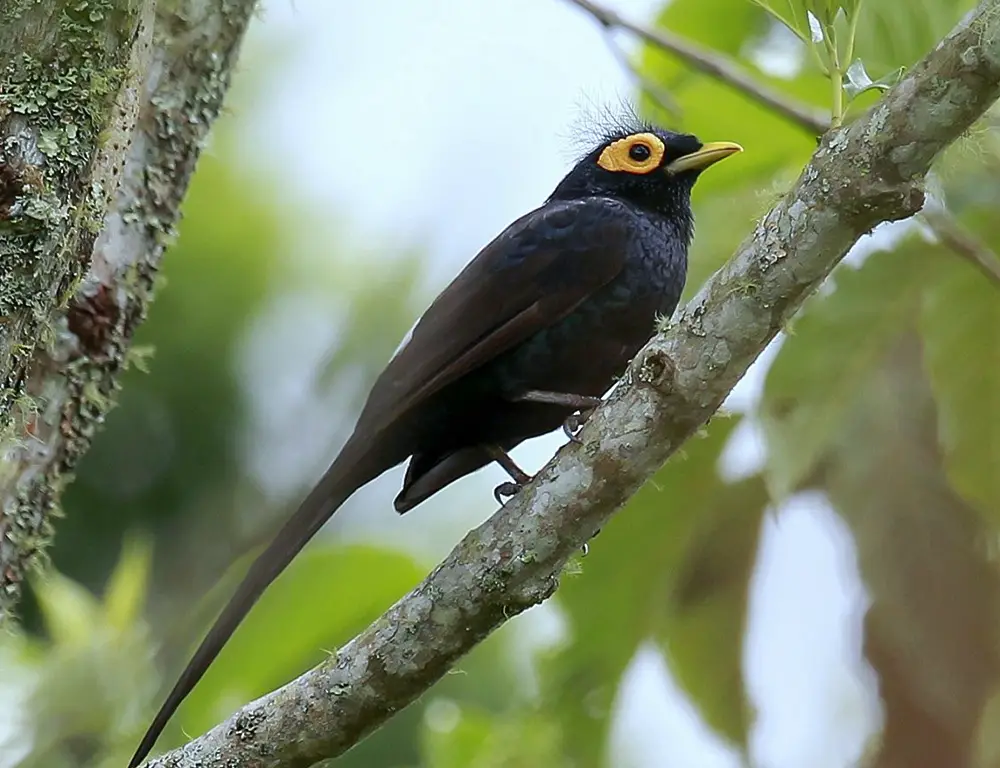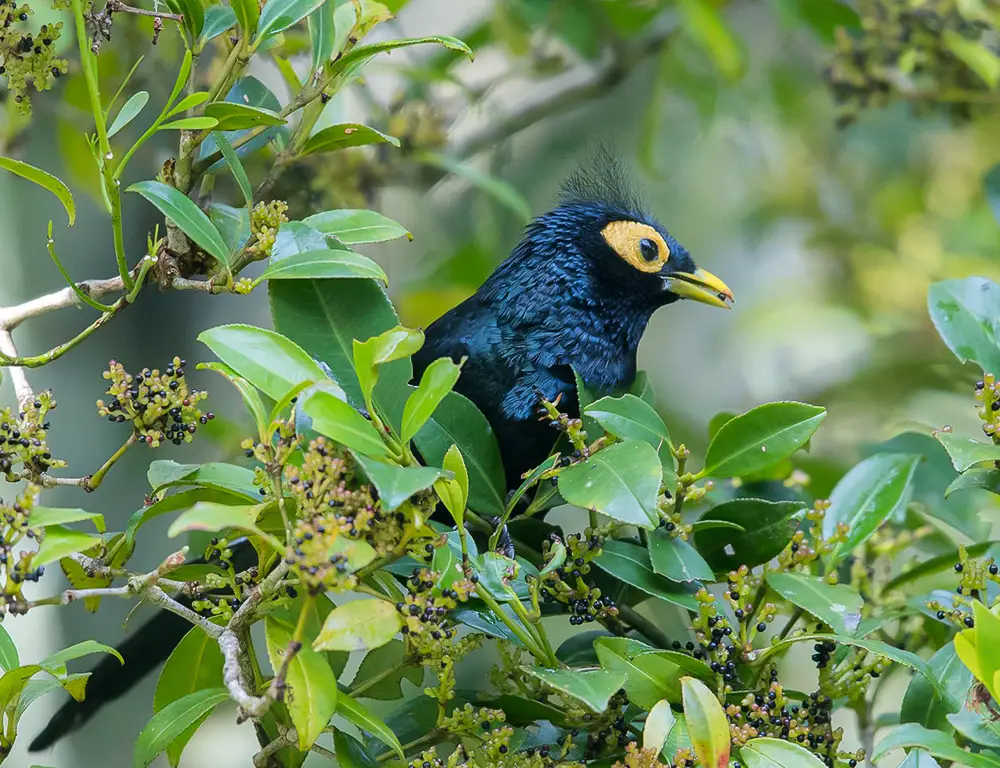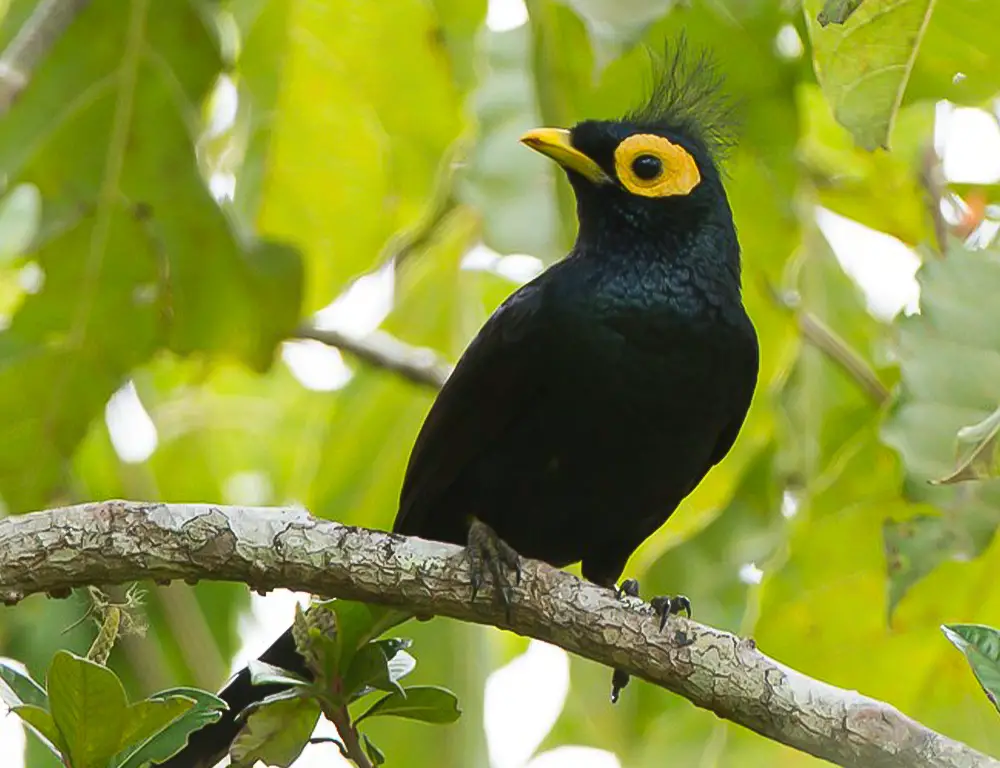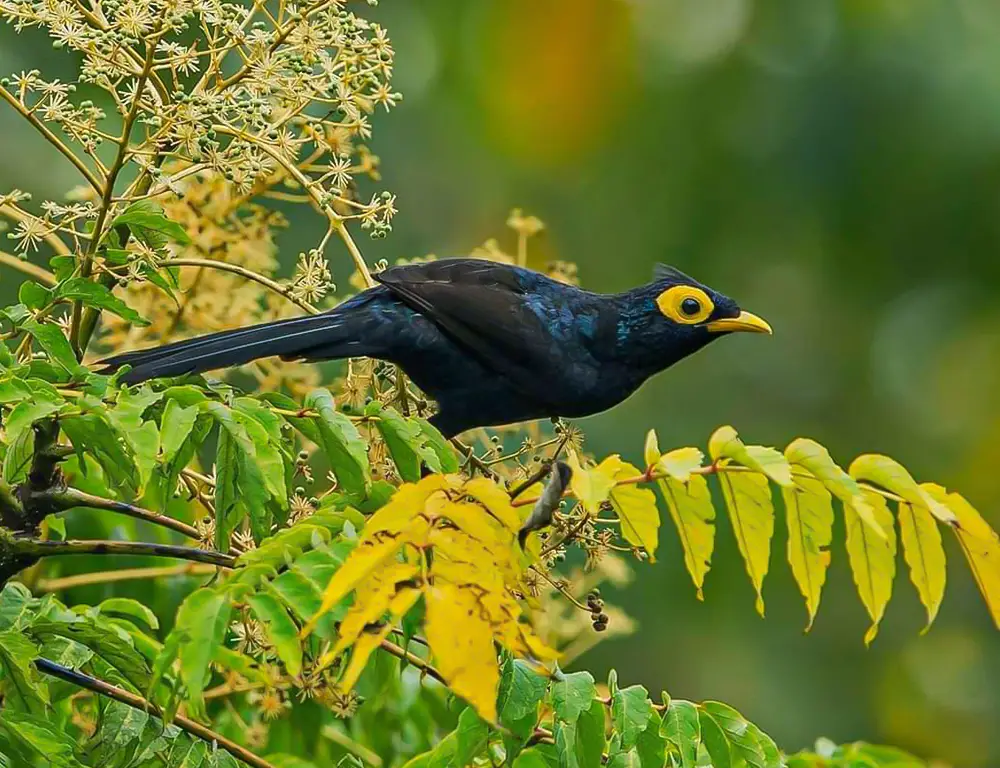Welcome to the vibrant world of Philippine biodiversity, where the Apo Myna takes center stage as a symbol of the country’s rich and diverse ecosystem.
With its striking appearance and unique behaviors, this avian inhabitant stands out among thousands of species found in the archipelago.
Sporting glossy black plumage adorned with bright yellow patches around its eyes and under tail coverts, the Apo Myna captures the imagination of nature enthusiasts and bird-watchers alike.
As we embark on this journey, we’ll delve into this remarkable bird species’ fascinating characteristics and behaviors, exploring how it has adapted to its environment and contributed to the rich tapestry of Philippine wildlife.
Join me in discovering the allure of the Apo Myna and the intricate ecosystem it calls home.

Habitat and Distribution of Apo Myna
The Apo Myna (Basilornis mirandus) is endemic to the Philippines and is primarily found in the montane forests of Mindanao Island.
Here’s a detailed look at its habitat and distribution:
Habitat
The Apo Myna inhabits subtropical or tropical moist montane forests, particularly in high-altitude areas. These forests are characterized by dense vegetation, including tall trees and thick undergrowth, providing ample cover and bird nesting sites.
The Apo Myna is often found in the canopy or mid-story of these forests, foraging for food and engaging in social interactions with other individuals.
Distribution
The distribution of the Apo Myna is limited to specific regions within the Philippines, particularly in the montane forests of Mindanao Island. Within Mindanao, it is primarily associated with two key mountain ranges:
- Mount Kitanglad: Located in the province of Bukidnon, Mount Kitanglad is one of the highest peaks in the Philippines and is home to a significant population of Apo Mynas.
The bird thrives in the montane forests of this mountain range, where it can be found at elevations ranging from 1,100 to 2,600 meters above sea level. - Mount Apo: Mount Apo, located in the province of Davao del Sur, is the highest mountain in the Philippines and another critical habitat for the Apo Myna.
Like Mount Kitanglad, Mount Apo’s montane forests provide a suitable bird habitat, supporting breeding populations at higher elevations.
Physical Characteristics of Apo Myna

The Apo Myna (Basilornis mirandus) boasts striking physical characteristics that make it a standout bird species within the avian world.
Here’s a detailed overview of its physical attributes:
Size
The Apo Myna is a medium-sized bird, typically measuring between 27 to 30 centimeters (approximately 10.6 to 11.8 inches) in length from beak to tail.
Weight
The weight of the Apo Myna (Basilornis mirandus) typically ranges around 180 grams (approximately 6.35 ounces). This weight measurement may vary slightly among individuals depending on age, sex, and overall health.
Shape
Its compact, stocky body has a relatively short neck and a proportionally long, tapered tail. Its body shape is well-adapted for navigating through the dense foliage of its forest habitat.
Plumage
The most prominent aspect of the Apo Myna’s appearance is its glossy black plumage covering most of its body. This sleek, shiny coat of feathers helps the bird stand out amidst the verdant greenery of its forest environment.
Additionally, its wings display patches of white, providing a striking contrast to the overall dark coloration.
Coloration
The Apo Myna exhibits a distinctive yellowish-orange patch of feathers surrounding each eye, extending to the area under its tail coverts. This vibrant coloring is a visually arresting feature, enhancing the bird’s allure.
Furthermore, its feet are adorned with bright yellow hues, adding another splash of color to its appearance.
Beak
Equipped with a strong, slightly curved beak, the Apo Myna is well-suited for its omnivorous diet. The beak’s robust structure enables the bird to efficiently forage for various food items, including insects, fruits, and seeds.
Vocalizations
While not strictly a physical characteristic, the Apo Myna’s vocal repertoire is noteworthy. It emits various calls, including whistles, squawks, and warbling notes.
Moreover, the bird can mimic sounds from its environment, further enriching its auditory communication.
Yellow Feet
Another striking feature of the Apo Myna is its bright yellow feet, which add color to its overall appearance. These colorful feet are visible when the bird is perched or in flight.
Behavior and Diet of Apo Myna

The behavior and diet of the Apo Myna (Basilornis mirandus) are fascinating aspects of its ecology. Here’s a closer look at these aspects:
Behavior
The behavior of the Apo Myna encompasses a range of fascinating activities that reflect its adaptation to life in the montane forests of the Philippines.
Here are some key aspects of its behavior:
Social Behavior
Apo Mynas are social birds congregating in small groups or pairs, especially during breeding season. They engage in various social activities, such as preening each other’s feathers, which helps strengthen social bonds within the group.
Their vocalizations are crucial in communication within the flock, conveying information about food sources, potential threats, and territorial boundaries.
Vocalizations
Apo Mynas are known for their diverse vocalizations, including whistles, squawks, and warbling notes. They also can mimic sounds from their environment, including other bird calls and human noises.
Vocal communication serves multiple purposes for Apo Mynas, including mate attraction, territory defense, and coordination during foraging.
Foraging Behavior
Apo Mynas employ various techniques when foraging for food, such as probing leaves with their sharp beaks and flipping over bark sections to uncover hidden insects.
They are primarily insectivorous, with beetles and caterpillars comprising a significant portion of their diet.
However, they also consume fruits and seeds opportunistically, mainly when insect prey is scarce.
Diet
The diet of the Apo Myna is primarily insectivorous, but it also includes fruits and seeds opportunistically. Here’s a closer look at its dietary habits:
Insectivorous Diet
Insects form the primary component of the Apo Myna’s diet, with a preference for beetles and caterpillars.
The birds actively seek These protein-rich prey items, which use their keen eyesight and agile beaks to capture them from foliage, tree bark, and other surfaces within their forest habitat.
Frugivorous Diet
While insects make up the bulk of their diet, Apo Mynas also consume fruits and seeds when available. They may supplement their insectivorous diet with fruits such as berries, figs, and seeds from various plant species.
This dietary flexibility allows the birds to adapt to changing food availability throughout the year.
Threats and Conservation Efforts of Apo Myna

The Apo Myna (Basilornis mirandus) faces several threats to its survival, primarily due to human activities and habitat degradation. However, various conservation efforts are underway to protect this species and mitigate these threats.
Here’s an overview of the threats and conservation efforts associated with the Apo Myna:
Threats
The Apo Myna faces several threats to its survival, primarily due to human activities and habitat degradation. Here are some of the critical threats:
Habitat Loss and Deforestation
One of the most significant threats to the Apo Myna is habitat loss and deforestation. The conversion of montane forests to agricultural land, logging activities, and urbanization have led to the destruction and fragmentation of its natural habitat, reducing available nesting sites and food sources for the birds.
Illegal Pet Trade
Wildlife traffickers often target the Apo Myna for the illegal pet trade due to its striking appearance and vocal abilities. This illicit trade further depletes wild populations and disrupts social structures within Apo Myna communities.
Invasive Species
Non-native species such as cats, rats, and snakes threaten the Apo Myna through predation and resource competition. These invasive species can negatively impact the bird’s nesting success and population dynamics.
Conservation Efforts
Conservation efforts aimed at protecting the Apo Myna and its habitat are essential for ensuring the survival of this unique bird species. Here are some key conservation initiatives:
Habitat Protection
Efforts are underway to conserve and protect the remaining montane forests within the Apo Myna’s range. This includes establishing protected areas and implementing forest conservation measures to prevent further habitat loss and degradation.
Law Enforcement
International and local laws regulate the capture, trade, and possession of the Apo Myna to combat illegal wildlife trafficking. Enforcement agencies work to apprehend and prosecute individuals involved in the illegal pet trade, reducing the demand for wild-caught birds.
Community Engagement and Awareness
Conservation organizations engage with local communities to raise awareness about the importance of conserving the Apo Myna and its habitat.
Community-based conservation initiatives empower local stakeholders to participate in habitat restoration, wildlife monitoring, and sustainable land management practices.
Research and Monitoring
Ongoing research and monitoring efforts provide valuable data on Apo Myna populations, habitat trends, and threats. This information informs conservation strategies and helps identify priority areas for conservation action.
Conclusion
The Apo Myna is a captivating bird species that holds a special place in the rich biodiversity of the Philippines. Its glossy black plumage, vibrant yellow eye patch, and unique behaviors have enchanted observers and researchers alike.
However, the species faces habitat loss, deforestation, and hunting threats, highlighting the urgent need for conservation action.
Through concerted efforts, including habitat protection, community engagement, and research, we can work together to safeguard the Apo Myna and its habitat.
By protecting this remarkable bird, we preserve a unique part of our natural heritage and contribute to the broader goal of conserving global biodiversity.
It’s our collective responsibility to ensure the survival of the Apo Myna and other species for future generations to appreciate and cherish.